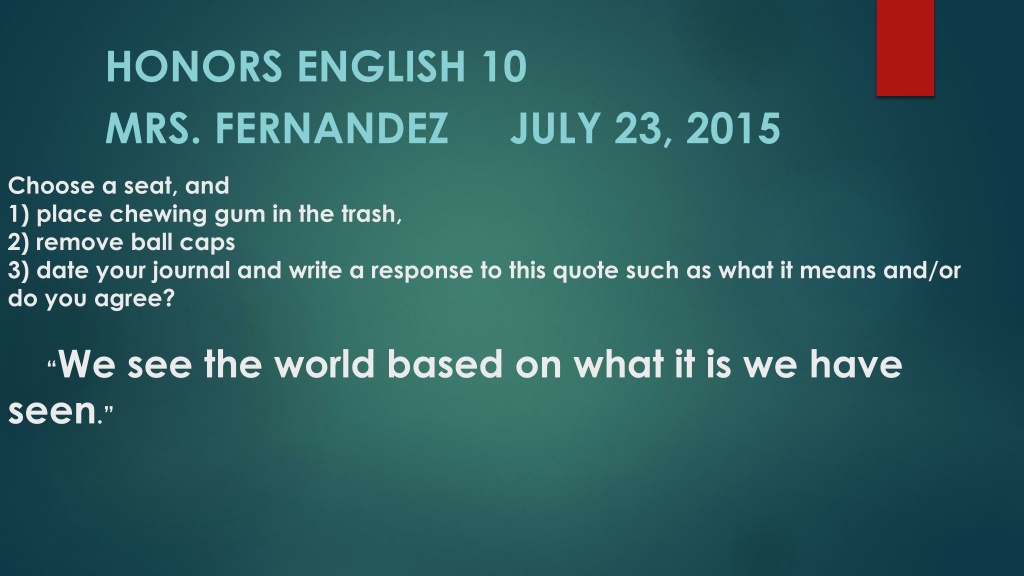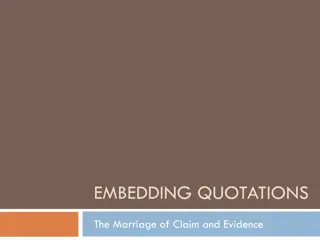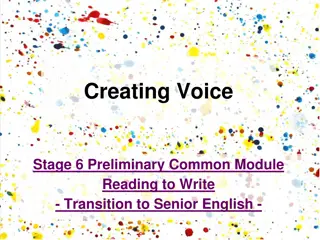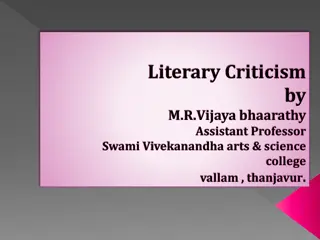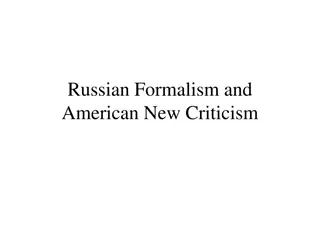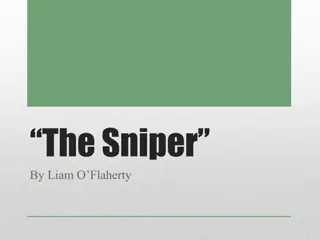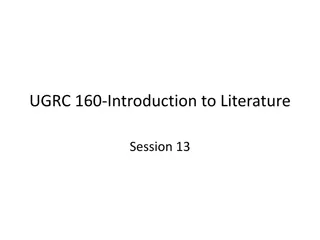Exploring Literary Elements and Techniques
Delve into literary devices such as characterization, plot, conflicts, and more to analyze and interpret stories effectively. Enhance your writing skills by practicing the incorporation of quotes and exploring different points of view. Develop a deeper understanding of the world through diverse perspectives and storytelling techniques.
Uploaded on Feb 18, 2025 | 0 Views
Download Presentation

Please find below an Image/Link to download the presentation.
The content on the website is provided AS IS for your information and personal use only. It may not be sold, licensed, or shared on other websites without obtaining consent from the author.If you encounter any issues during the download, it is possible that the publisher has removed the file from their server.
You are allowed to download the files provided on this website for personal or commercial use, subject to the condition that they are used lawfully. All files are the property of their respective owners.
The content on the website is provided AS IS for your information and personal use only. It may not be sold, licensed, or shared on other websites without obtaining consent from the author.
E N D
Presentation Transcript
HONORS ENGLISH 10 MRS. FERNANDEZ JULY 23, 2015 Choose a seat, and 1) place chewing gum in the trash, 2) remove ball caps 3) date your journal and write a response to this quote such as what it means and/or do you agree? We see the world based on what it is we have seen.
July 23rd, 2015 Agenda We will review the Summer Reading Project s -Literary Pr cis - Device Analysis Paragraphs We will review integrating quotes into our writing. You will practice integrating quotes into your writing.
Literary Device Analysis Literary devices are common structures used in writing. These devices can be either literary elements or literary techniques. Literary elements are found in almost every story and can be used to analyze and interpret (e.g. protagonist, setting, plot, theme). Literary techniques, on the other hand, constructions in the text, usually to express artistic meaning through the use of language (e.g. metaphor, hyperbole).
Novel Study Details the literary elements: Characterization Plot/Climax Point of View/Narration Conflicts Themes Setting/Mood/Tone Symbols
Literary Prcis THIS IS NOT A RHETORICAL PRECIS Literary Pr cis Format for Introduction Paragraph Sentence #1: In the ______________, __________________, by _____________________ (date), the idea that_________________is developed. (Genre) (Title) (Author) (Main idea/theme) EX: In the novel, To Kill a Mockingbird, by Harper Lee (1960), she develops the idea that understanding where a person comes from before making judgments about them is essential to living a peaceful life.
Literary Prcis Sentence 2 Sentence #2: Told in _______________ person point-of-view, and set in _____________________________,the story is about ( P.O.V.) (Setting) _________________________ (as they, who) _________________________________________________________ _________. (Main characters) (brief summary statement of plot) Journal entry: Jot down as many types of point-of-view you know.
Point-Of-View In literature, point-of-view is the perspective of the author. First I and We pronouns Second (rare)- employs you pronoun Third He , She , They pronouns Limited Reveals the thoughts and feelings of one character Omniscient-Reveals the thoughts and feelings of all characters
EX: Told in first person point-of-view, and set in Maycomb county Alabama in the 1930 s, the story is about a young girl name Scout who, along with her brother and friend, witness the unfair trial of a black man, and who try to befriend a reclusive neighbor.
Literary Prcis Sentence 3 Sentence #3 _____________ develops the story and theme predominately through the use of ___________________________________. (Author s last name) (list types of literary devices BUT DON T LIST ALL 9) Journal entry: In one minute, jot down as many literary devices as you can.
Literary Devices to name a few: http://literarydevice/
EX: Lee develops the story and theme predominately through the use of dialogue, similes, and personification.
Literary Prcis Sentence 4 Sentence #4: ________________________ s purpose is to ___________________________ in order to ____________________________. (Author s Last name) (Author s purpose) (Intended reason for theme) Dialogue: What s a theme?
Theme - We see the world based on what it is we ve seen. Share with a neighbor the response you wrote for today s warm-up.
EX: Lees purpose is to show the consequences of judging others before understanding them in order to create a more peaceful and giving society. Harper Lee was born in 1926 in Monroeville, Alabama What was the world she saw ? How does how she grew up relate to To Kill a Mockingbird ?
Put it all together: Full Introduction Paragraph Example: In the novel, To Kill a Mockingbird, by Harper Lee (1960), she develops the idea that understanding where a person comes from before making judgments about them is essential to living a peaceful life. Told in first person point-of-view, and set in Maycomb county Alabama in the 1930 s, the story is about a young girl name Scout who, along with her brother and friend, witness the unfair trial of a black man and who try to befriend a reclusive neighbor. Lee develops the story and theme through the use of dialogue, similes, and personification. Lee s purpose is to show the consequences of judging others before understanding them in order to create a more peaceful and giving society.
Literary Device Paragraphs Correlate three paragraphs with the beginning, the middle, and the end of the novella. Journal entry: A novella is a written, fictional, prose narrative that is longer than a short story but shorter than a novel. A prose narrative is basically a text that tells a story.
Literary Device Paragraphs NINE literary devices Steinbeck uses should be identified and analyzed with regards to how he utilizes them to make his claim; you must analyze at least three devices in each paragraph, but you may analyze more than three. The literary devices analyzed may be repeated . Textual evidence (ie: quotes) should be incorporated; no more than two quotes per paragraph.
MAKE THE CONNECTION ! Consider how the literary device works in the novel and contributes to the meaning of the work (theme-- as stated in the theme paragraph) as a whole. Consider why the author elected to use this device to advance some artistic purpose in the work. Beware of using general comments; rather be specific in making the connection. Effective discussion will begin with the WHAT and proceed very quickly and perceptively to the HOW and WHY.
Sample Scout s narrative begins reminiscent of her childhood s setting in Maycomb County, Alabama during the Great Depression. Familiar with her family s history, she provides details of her ancestor s pilgrimage from England to the states and provides explicit imagery about her isolated, yet fondly remembered hometown. She, her father Atticus who, knew his people, they knew him, and was related by blood or marriage to nearly every family in the town , her brother Jem, and their cook, Calpurnia, rarely ventured beyond the county line (Lee 2). Whether by choice or by circumstance, the townspeople interacted closely only with each other and were leery of anyone from outside the region. Even as a 6 year old, Scout was extremely knowledgeable about the families who lived in her town she explained to her new young teacher that, you re shamin him Miss Caroline. Walter hasn t got a quarter at home to bring you when the teacher tried to offer a poor child money for lunch (Lee 16). The independent and assertive little girl (symbolized by her decision to wear pants as opposed to skirts), suggests to her lawyer father that she be homeschooled when he asks her to consider the teacher s point of view.
Home symbolizes the peace that comes from being in a familiar and comfortable atmosphere; the new teacher represents conflict and unfamiliarity. One newcomer whom Scout and her brother did however accept is another child nicknamed Dill who visits his Aunt every summer. Dill becomes determined to force a reclusive neighbor - aptly named Boo Radley because the townspeople are scared of him out of his house. Much of the novel s beginning focuses on the children s unsuccessful attempts to entice Boo out of his comfort zone; as curious and innocent kids, they are looking for ways to pass the long summer days, but there is a sense of danger foreshadowed by their actions. Even though many townspeople think Boo Radley is crazy and/or dangerous, he is accepted as another member of the community. This community finds peace in what is familiar; to them it is better to deal with those they know regardless of how poor or how strange because with change and/or anything different than what they know comes conflict and struggle.
Integrating Quotes PURPOSE: Your paper develops the argument as to what the author is doing and how the text works . Quotes prove your point they are meant to support what you are claiming. Don t quote to tell the story or simply to fill up space in your paper! Use only what you need ellipses ( ) work in place of unneeded text. Even as a 6 year old, Scout was extremely knowledgeable about the families who lived in her town she explained to her new young teacher that, you re shamin him Miss Caroline. Walter hasn t got a quarter at home to bring you when the teacher tried to offer a poor child money for lunch (Lee 16).
Integrating Quotes Quotes are like small children; they should never be left alone! Your sentences that come before and/or after the quote are the grown-ups holding the hand of the small child. INCORRECT: T.S. Eliot, in his "Talent and the Individual," uses gender-specific language. "No poet, no artist of any art, has his complete meaning alone. His significance, his appreciation is the appreciation of his relation to the dead poets and artists" (Eliot 29). CORRECT: T.S. Eliot, in his "Talent and the Individual," uses gender- specific language. He argues, for instance, that "no poet, no artist of any art, has his complete meaning alone. His significance, his appreciation is the appreciation of his relation to the dead poets and artists" (Eliot 29).
Four Ways (at least) to Integrate Quotes: Introduce the quotation with a complete sentence and a colon. Albert Einstein reminds us all to never waste our life being selfish: Only a life lived for others is worth living" http://ivcc.edu/Rambo/eng1001/quotes.htm
Integrating Quotes #2 - Use an introductory or explanatory phrase, but not a complete sentence, separated from the quotation with a comma. Homer Simpson shouted, "I am so smart! I am so smart! S-M-R-T! I mean, S-M-A-R-T! According to Mrs. Fernandez, We see the world based on what it we have seen. http://ivcc.edu/Rambo/eng1001/quotes.htm
Integrating Quotes #3- ATTRIBUTION Make the quotation a part of your own sentence without any punctuation between your own words and the words you are quoting. Jerry Seinfield once said that there are Four Levels of Comedy: make your friends laugh, make strangers laugh, get paid to make strangers laugh, and make people talk like you because it's so much fun." http://ivcc.edu/Rambo/eng1001/quotes.htm
Integrating Quotes #4 Use short quotations--only a few words--as part of your own sentence. An Irish saying reminds us that friends that gossip with you may also be friends that gossip about you. http://www2.ivcc.edu/rambo/eng1001/quotes.htm
Final Thoughts - http://www2.ivcc.edu/rambo/eng1001/quotes.htm You Tube
Try it! Choose one of the following quotes: Author: Ray Charles - "I never wanted to be famous. I only wanted to be great." Author: Dick Clark - "Music is the soundtrack of your life." Author: Homer Simpson - "Remember as far as anyone knows, we're a nice normal family" Author: Indira Gandhi - "Where there is love there is life." Author: Red Barber - "Baseball is dull only to dull minds." Author: Vince Lombardi - "If winning isn't everything, why do they keep score?" Author: Dr. Seuss - Don't cry because it's over, smile because it happened. Author: Oscar Wilde - Be yourself; everyone else is already taken. Author: Bernard M. Baruch - Be who you are and say what you feel, because those who mind don't matter, and those who matter don't mind. In your journal, write four complete sentences using each of the four ways to integrate quotations.
